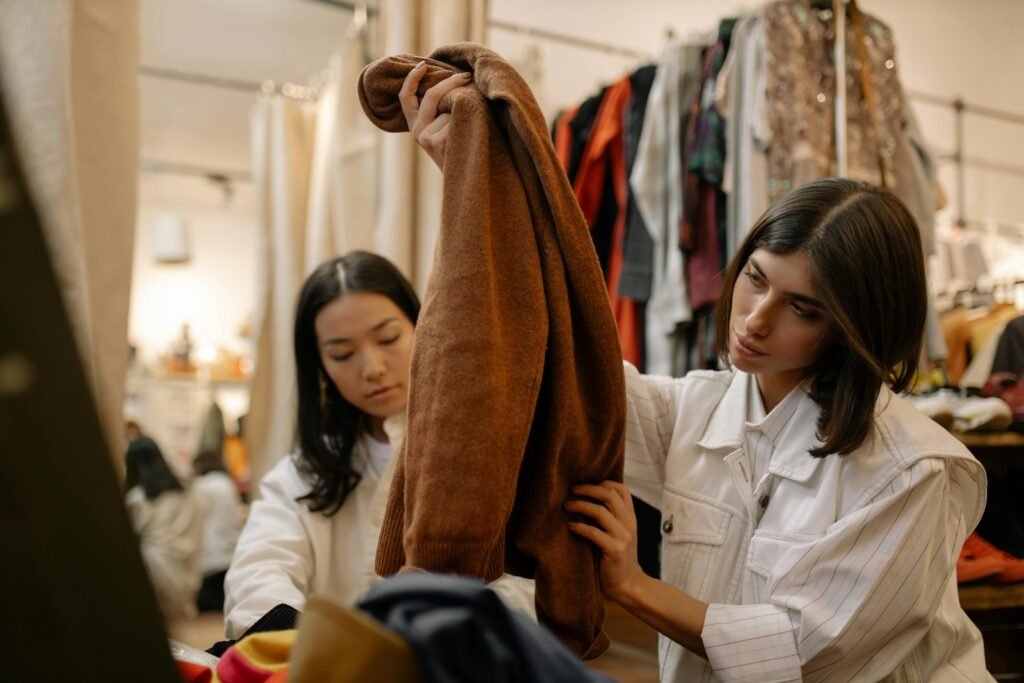In today’s environment, striking the ideal balance between sustainability, affordability, and fashion may be difficult. A lot of people feel stuck in the middle since fast fashion offers stylish, affordable clothes at the expense of ethical and environmental issues, while high-end sustainable products can have expensive price tags. The good news is that you don’t have to spend a fortune to assemble a wardrobe that is sensible and fashionable. Here’s how to purchase clothing that isn’t expensive or quick fashion.

The Problem with Fast Fashion
The term “fast fashion” describes the quick creation of inexpensive, stylish apparel that mimics the newest runway trends. Even if it’s convenient and reasonably priced, the real cost is far higher. The business has serious problems because of its heavy environmental impact and reliance on low-wage labor. Poor-quality materials are frequently used in the production of clothing, which causes the items to snag easily and adds to the expanding issue of textile waste.
The High Cost of Sustainable Fashion
However, even though many sustainable fashion labels are ecologically and morally responsible, they may be expensive. Naturally, the cost is higher for these businesses since they frequently utilize premium, environmentally friendly products and guarantee their employees receive fair compensation and safe working conditions. These items might not be within everyone’s means, even if they are a great investment for those who can buy them.
Striking a Balance: Practical Tips
It is feasible to find a compromise where you can have fashionable, high-quality apparel without negatively impacting the environment or your bank account.Here’s how:
1. Do Your Research
Before you buy, take some time to research brands that prioritize sustainability but don’t charge a premium. Brands like Everlane, People Tree, and PACT offer transparency about their production processes and materials, making it easier to make informed choices. Websites like Good On You rate brands on their ethical and environmental practices, providing a valuable resource for conscientious shoppers.
2. Prioritize Quality Over Quantity
One of the keys to avoiding fast fashion is focusing on the quality of the items you purchase. Look for clothing made from durable materials such as organic cotton, linen, wool, or recycled fabrics. Well-constructed garments will last longer, providing better value for money. Check seams, zippers, and fabric strength before making a purchase.
3. Shop Sales and Off-Season
Good clothes doesn’t necessarily have to cost a lot of money. All year long, there are several deals and discounts offered by sustainable businesses. Subscribe to emails from your preferred businesses to learn about bargains and promotions toward the end of the season. Purchasing off-season is another excellent approach to get discounts on premium goods.
4. Embrace Second-Hand Shopping
A wealth of fashionable, reasonably priced, and environmentally friendly clothing alternatives may be found at thrift stores, consignment stores, and online retailers such as Depop, Poshmark, and ThredUp. Purchasing used goods is more cost-effective and benefits the environment by lowering the need for new manufacturing. Additionally, distinctive items that stand out from the mass-produced throng can be found by vintage shopping.
5. Invest in Versatile Pieces
One clever method to make the most of your clothes budget is to create a flexible wardrobe that includes essential pieces that can be combined and matched. Basic pieces that can be dressed up or down for different occasions are a fitting jacket, a little black dress, or a pair of jeans. Purchasing classic items guarantees longevity and lessens the need for frequent replacements.
6. Take Care of Your Clothes
Wear and tear can be minimized and clothes can retain their shape longer when properly cared for. To keep your clothes looking their best for longer, check for minor damages like loose threads or small holes on a regular basis. Washing instructions should be carefully followed; use cold water to prevent fabric damage and avoid over-washing.
7. DIY and Upcycling
Using existing wardrobe creatively may be another enjoyable and eco-friendly method to update your look without having to buy new items. You may give garments a new lease of life by altering or repairing them using basic sewing abilities. Upcycling, or transforming old garments into something new, is a great way to express your creativity and reduce waste. To get you started, there are a ton of tools and lessons available online.
Conclusion
It is not only feasible but also satisfying to design a wardrobe that strikes a balance between price and sustainability. You may have fashionable and long-lasting clothes without going over budget by emphasizing quality, looking into ethical companies, taking advantage of bargains, and considering second-hand possibilities. Plus, you can prolong the life of your garments and maintain a current look by taking good care of them and using your creativity in do-it-yourself projects. Recall that being fashionable shouldn’t mean sacrificing your morals or your standard of living. Cheers to your shopping!


